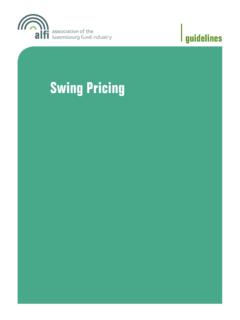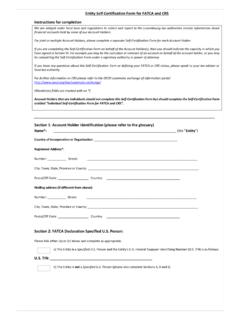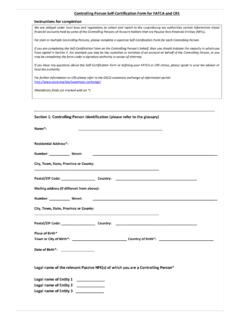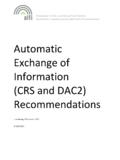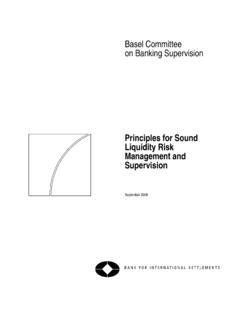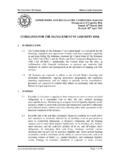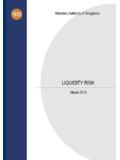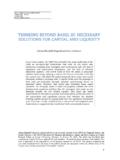Transcription of risk management - ALFI
1 Risk managementguidelinesin association with3 Foreword 4 Chapter I 6 Best practice proposals for the organisation of the risk Function of a UCItS management Company or UCItS Investment Company 8 Chapter II 29 Guidance paper for the risk monitoring of functions outsourced/ delegated by a management company or investment company 30 Chapter III 44aLFI industry work paper - collateral management 46appendix I - glossary 59appendix II - aLFI risk management Committee and SC 62table of contents4forewordThe financial crisis has demonstrated how important it is to have in place an effective and robust risk management organisation. In today s ever more complex business environment investment firms are required to implement sound risk principles and oversight mechanisms.
2 This is not only of interest for individual entities, but for the financial groups overall. The global integration of markets, business and operations triggers an integrated risk management framework . Risk management has become a dominant topic in a number of recent regulations. Whereas in the context of UCITS IV risk management has been confirmed and clearly be expanded beyond the traditional focus on market risk, the AIFMD has now introduced this broad concept of risk management as an integral part of the responsibilities of the AIFM. In addition to the product specific risk management regulations, the EU regulator prepares new guidelines regarding the trading of OTC derivatives and central counterparties. Besides fostering a risk awareness culture and a holistic approach to risk management as such, it has become apparent that risk governance is paramount to the successful business conduct.
3 As the European centre for UCITS fund domiciliation and distribution, Luxembourg is positioned as the crossroad of regulatory risk management requirements and distribu-tion risk practice, the fund industry has organized its risk management processes in a centralized manner, supported by dedicated centers of excellence defined within each major asset management group. The centralization is a consequence of the increased sophistication of the risk management as well as the economies of scale in terms of systems and data history. We believe that the scope of risk manage-ment as required by the regulator does broaden the responsibilities of the manage-ment company and by such the risk management function. Due to its exposed positioning in product governance and international distribution, Luxembourg has developed the overall understanding of the entire value chain and is as such well placed to play a leading role in risk management .
4 In light of the holistic risk management approach, ALFI has created within its risk management committee which focuses and all aspects of risk management in relation to Luxembourg domiciled investment funds, proposes common interpretations, simplifica-tions or market industry standards and prepares responses to consultations issued by national or international bodies. The working groups (market risk, liquidity risk, credit and counterparty risk as well as operational risk) address the risk categories as outlined by the UCITS IV Directive and its implementing measures. In the present guidance paper, we hereby present the first results of some of these working groups. We attached a special focus on the key risk topics that are newly addressed by UCITS IV.
5 It is the intention of this publication to assist the market players in the pragmatic opera-tional implementation of these regulations. 1 Liquidity risk Q The liquidity risk is a risk which has been underestimated for quite a long period, in particular for certain asset classes assumed to be liquid based on quotes from a limited number of market makers. Measuring the liquidity risk is subject to two main dimensions, (i) assets and (ii) liabilities of the UCITS. In particular the liability aspect is tricky due to the intransparent and very complex distribution structure making a full assessment of the investor base impossible. The present guidance intends to propose practical measures to address asset liquidity a holistic approach to risk management moving up the agenda52 Credit & counterparty risk Q The assessment of counterparty risk has undergone a complete reversal and has become a major risk to be managed for all UCITS dealing in OTC contracts.
6 In particular the measurement of the risk as well as the changing market practice with regards to collateralisation put additional pressure on risk management and operational procedures for ManCo s. The role of the collateral managers in relation to the depositary is currently unclear and triggers additional issues one needs to take into consideration. The guidance paper summarises sound industry practices regarding counterparty risk mitigation and collateral management . 3 operational risk Q The need to manage operational risk is well known and thus not a new aspect in the fund industry, but has become a focal point for regulation in the last years. The term itself refers to potential causes of loss arising from deficiencies in internal controls, human errors, physical systems failures, and other business execution risks as well as external events.
7 Since Luxembourg is traditionally making use of delegations to third parties, the market participants have built up experience in managing outsourcing risks over many years. The guidance paper has summarised selected best practice measures to monitor outsourced functions and fund specific measures on operational risks . However, the guidance given has to be put into perspective of the respective company environment and business model. Also, the risk management process is subject to the principle of proportionality as introduced by UCITS would like to thank all the participants of the working groups for their dedication and most valuable input. We are very much looking forward to the new guidance papers currently in process as well as meeting you on the events we will organize in the next hope that you find these Guidelines interesting and useful.
8 Sincerely, ALFI Association of the Luxembourg Fund Industrychapter IBest Practice Proposals for the Organisation of the Risk Function of a UCITS management Company or UCITS Investment Company7 IntrodUCtIon and LeGaL and reGULatory framework 81 IntrodUCtIon 82 key LeGaL and reGULatory framework 8rISk management prInCIpLeS, rISk management FUnCtIon and other ControL FUnCtIonS 91 rISk management FUnCtIon - prInCIpLeS 92 rISk management and ItS reLatIonShIp wIth other ControL FUnCtIonS 10 BeSt praCtICe propoSaLS on praCtICaL IMpLeMentatIon oF a rISk management FUnCtIon 121 GovernanCe and orGanISatIon establishment of a rM function role of the ManCo Board of directors role of Senior management /Conducting officers examples for rM governance structures Larger/More Complex management Company Structures Smaller management Company Structures other organisational
9 Structures risk management Strategy/policy 162 IdentIFICatIon oF risks potential risks directly affecting UCItS potential risks affecting both UCItS and ManCo 183 MeaSUreMent and management oF risks 204 reportInG General principles on effective reporting of risks to Senior management and the Board Content and Frequency of reporting Content and Frequency of reporting to the Cos Content and Frequency of reporting to the management Company or SICav Board 23roLe oF rISk management In the LIFe-CyCLe oF a FUnd 24 appendIX LawS and reGULatIonS 25 Content8 Best Practice Proposals for the Organisation of the Risk Function of a UCITS management Company or UCITS Investment CompanyIntroduction and legal and regulatory framework1 IntroductionRecent EU regulation, as implemented in Luxembourg by the Law of 2010, introduced in connection with the latest revision to the UCITS Directive, has focused attention on the requirement for management companies, pursuing the activity of management of a UCITS, and investment companies, that have not designated a management Company (Self Managed SICAV), to have in place an adequate Risk management ( RM ) function that is proportionate to the business conducted by those companies and the risk profiles of the UCITS which they manage.
10 The aim of this document is: Qto highlight, in the first place, the key legal and regulatory sources in relation to RM in order to get a common understanding thereof and; Qto propose a set of best practices that the Boards and Senior management of management Companies and Investment Companies may wish to consider when developing, or reviewing the adequacy of, their RM functions. Throughout this document ManCo will be used to refer to a management company, or a self managed investment company where no management company has been key legal and regulatory frameworkIn relation to risk management a number of laws and regulations have been issued on European and Luxembourg level. In the following, please find a brief overview table including a non-exhaustive list of the key legal and regulatory framework in relation to risk framework on risk Managementeuropean UnionLuxembourgLevel 1 legislationDirective 2009/65/ECLaw of 17 December 2010 on Undertakings for Collective Investment (2010 Law replaces the 2002 Law)



